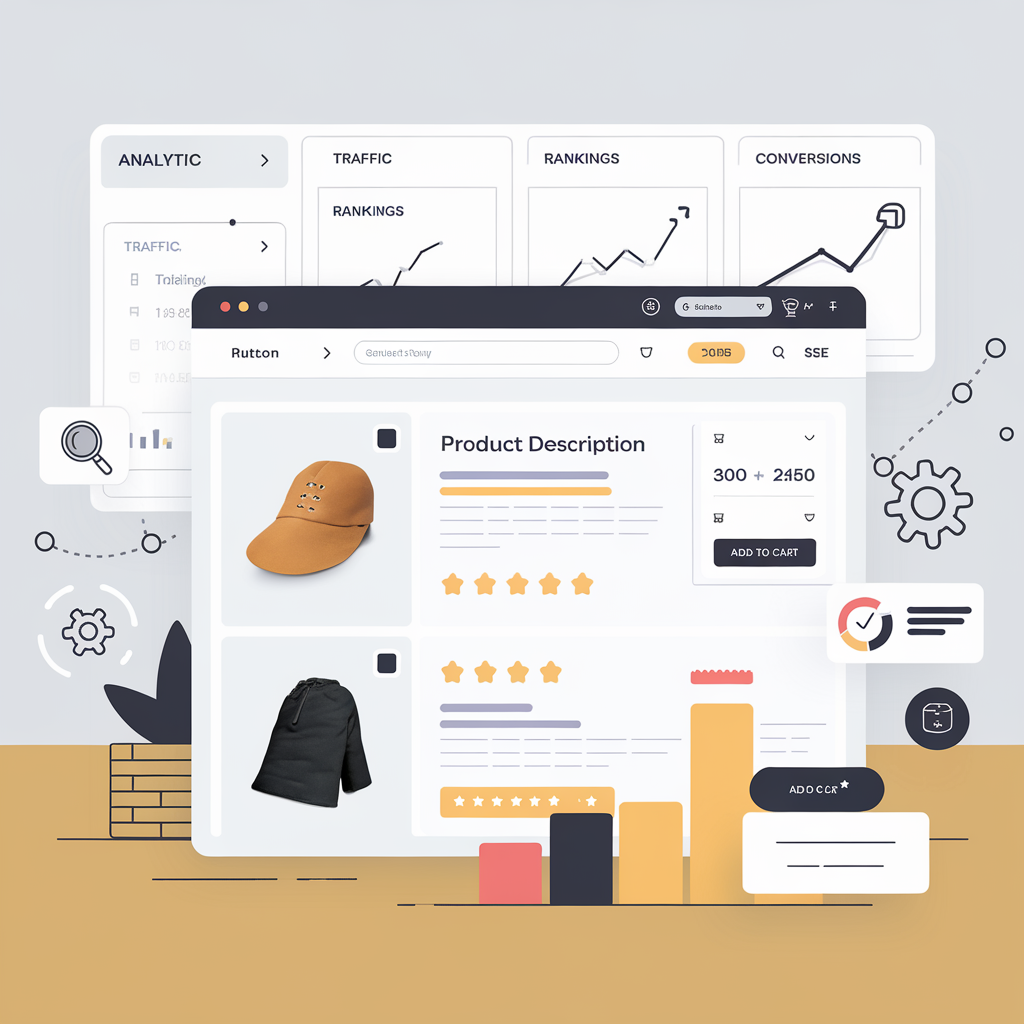What are the key strategies for product page SEO?
In the bustling world of e-commerce, standing out is a challenge. Every online store is vying for the attention of potential customers. The competition is fierce. But there’s a secret weapon that can give you an edge: Product Page SEO. SEO, or Search Engine Optimization, is a set of strategies used to improve a website’s visibility on search engines.
When done right, it can drive a significant amount of organic traffic to your site. And when it comes to e-commerce, product page SEO is crucial. Why? Because your product pages are where the magic happens. They’re where visitors become customers. They’re where your products get the spotlight they deserve.
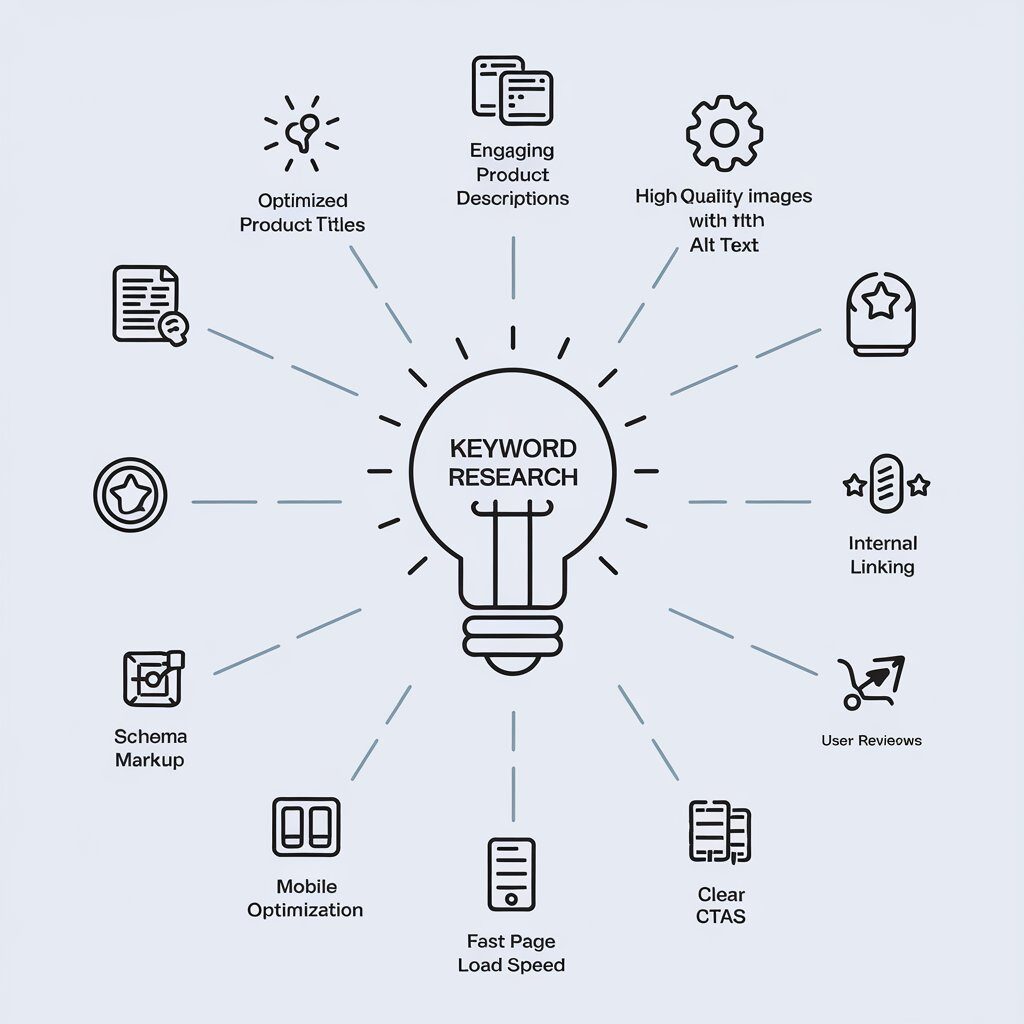
But optimizing these pages for search engines is not a walk in the park. It requires a deep understanding of SEO best practices, a keen eye for detail, and a strategic approach. In this comprehensive guide, we’ll delve into the key strategies for product page SEO. We’ll explore everything from keyword research and on-page SEO, to technical considerations and conversion rate optimization.
Whether you’re an e-commerce business owner, a digital marketer, or an SEO specialist, this guide is for you. By the end of it, you’ll have a clear roadmap to optimize your product pages, boost their visibility on search engines, and ultimately, increase your sales. So, are you ready to dive in? Let’s get started.
Understanding the Importance of Product Page SEO
In the realm of e-commerce, product pages are the heart of your online store. They’re the digital storefronts that showcase your products to the world. But their role goes beyond just displaying product information.
Product pages are the key touchpoints that can turn a casual browser into a paying customer. They’re where your visitors make the decision to add a product to their cart or abandon it. But to get visitors to your product pages in the first place, you need to make them visible to search engines. That’s where product page SEO comes in.
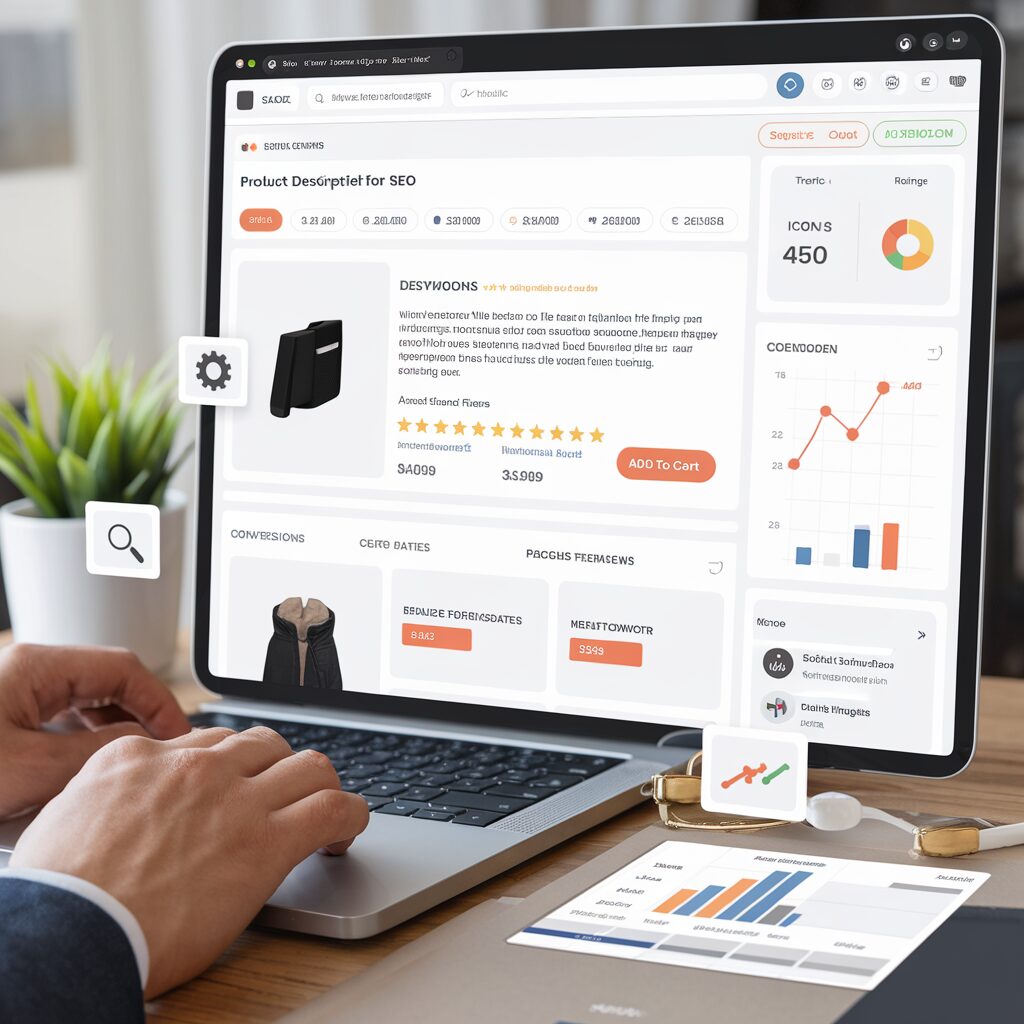
Here are some reasons why product page SEO is crucial:
- Driving organic traffic: Well-optimized product pages can rank high in search engine results, attracting more organic traffic to your site.
- Increasing visibility: SEO helps your product pages stand out in the crowded online marketplace, making it easier for potential customers to find your products.
- Boosting conversions: By providing relevant and valuable content, SEO can enhance the user experience, encouraging visitors to convert into customers.
- Building credibility: A high ranking on search engines can enhance your brand’s credibility, as users often perceive top-ranking sites as more trustworthy.
- Improving user experience: SEO involves optimizing the overall user experience, from the site’s loading speed to its navigability, which can lead to higher customer satisfaction and loyalty.
In the following sections, we’ll explore the key strategies to optimize your product pages for search engines. Let’s start with the foundation of any SEO strategy: keyword research.
The Role of Keyword Research in Product Page Optimization
Keyword research is the cornerstone of any SEO strategy. It’s the process of identifying the words and phrases that people use when searching for products like yours. By understanding these keywords, you can optimize your product pages to match these search queries. This can help your pages rank higher in search engine results, making them more visible to potential customers.
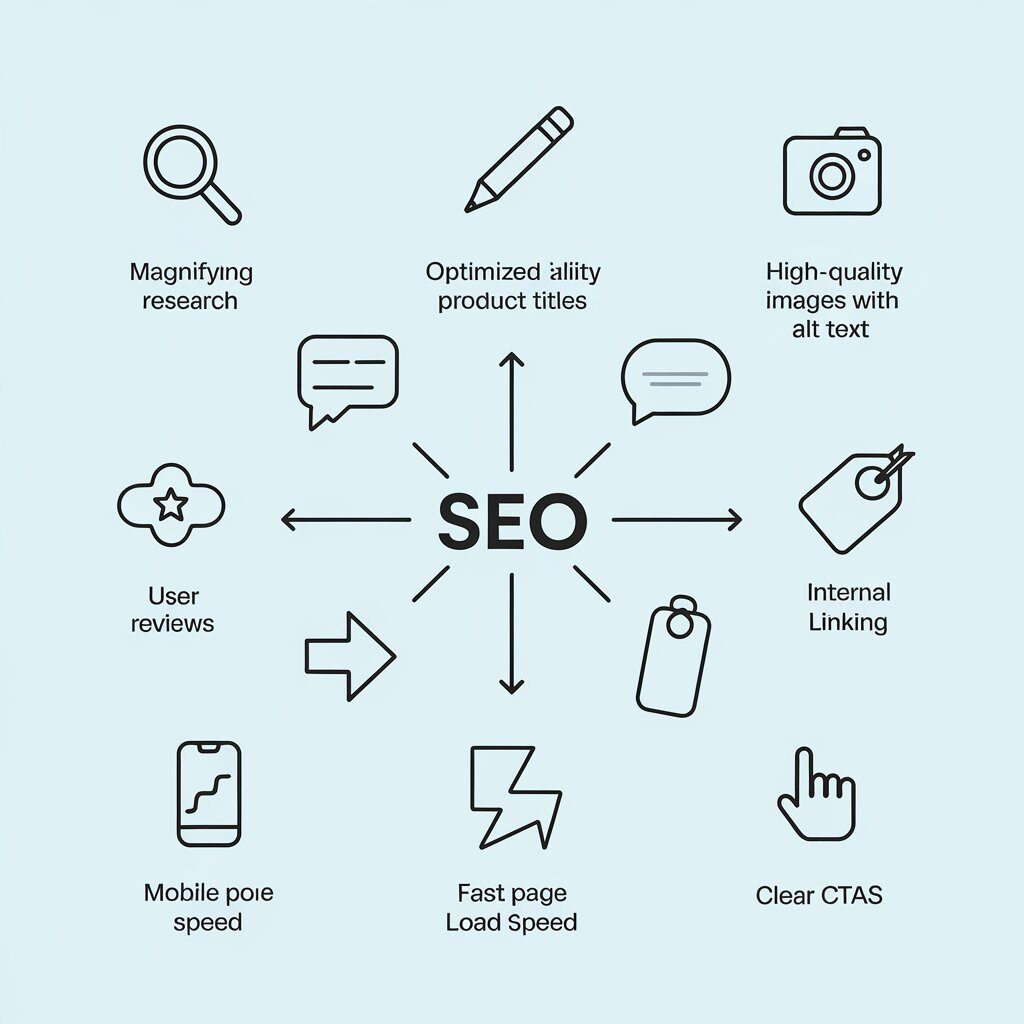
But keyword research isn’t just about finding the most popular search terms. It’s also about understanding the intent behind these searches. For product pages, the search intent is often transactional, meaning the user is looking to make a purchase. By targeting these transactional keywords, you can attract visitors who are ready to buy, increasing your chances of making a sale.
Here are some key considerations for keyword research:
- Relevance: The keywords should be relevant to your products and the information on your product pages.
- Search volume: Ideally, the keywords should have a high search volume, indicating that many people are using these terms in their searches.
- Competition: The level of competition for a keyword can affect your chances of ranking high in search results. It’s often easier to rank for long-tail keywords (longer, more specific phrases) as they tend to have less competition.
- Intent: As mentioned earlier, the intent behind the search is crucial. For product pages, focus on keywords with transactional intent.
Identifying Your Target Keywords
Identifying your target keywords is the first step in keyword research. Start by brainstorming a list of words and phrases related to your products. Think about how your customers might describe your products. What terms would they use in a search query? Consider the features, benefits, and uses of your products.
Also, think about the problems your products solve. People often search for solutions to their problems, so these can be valuable keywords. Once you have a list of potential keywords, you can use keyword research tools to refine your list.
Tools and Techniques for Effective Keyword Research
There are many tools available to help with keyword research. Google’s Keyword Planner is a popular choice. It provides data on search volume and competition for different keywords. Another useful tool is SEMrush, which offers detailed keyword analytics. It can show you the top-ranking pages for a particular keyword, giving you insights into your competition.
Ubersuggest is another tool that can provide keyword suggestions based on your initial list. These tools can help you identify high-performing keywords for your product pages. But remember, keyword research is not a one-time task. Search trends change over time, so it’s important to revisit your keyword strategy regularly. This will ensure your product pages stay relevant and continue to attract organic traffic.
Crafting Compelling Product Titles and Descriptions
The title and description of your product page play a crucial role in SEO. They not only help search engines understand what your page is about, but also influence the click-through rate from the search results. A compelling, keyword-rich title and description can make your product page stand out in the search results, attracting more clicks and traffic.

But remember, while keywords are important, they should not be forced or overused. Your title and description should be natural and engaging, providing clear and accurate information about your product. They should also be unique for each product page to avoid duplicate content issues. Let’s delve deeper into how to craft SEO-friendly product titles and descriptions.
Writing SEO-Friendly Product Titles
The title of your product page is one of the most important elements for SEO. It’s often the first thing that search engines and users see, so it needs to be compelling and informative. Your product title should clearly describe what the product is, incorporating your target keyword where it naturally fits.
Keep your titles concise and to the point. Avoid unnecessary words or phrases that don’t add value. Also, be consistent in your title structure across all product pages. This not only helps with SEO but also provides a better user experience.
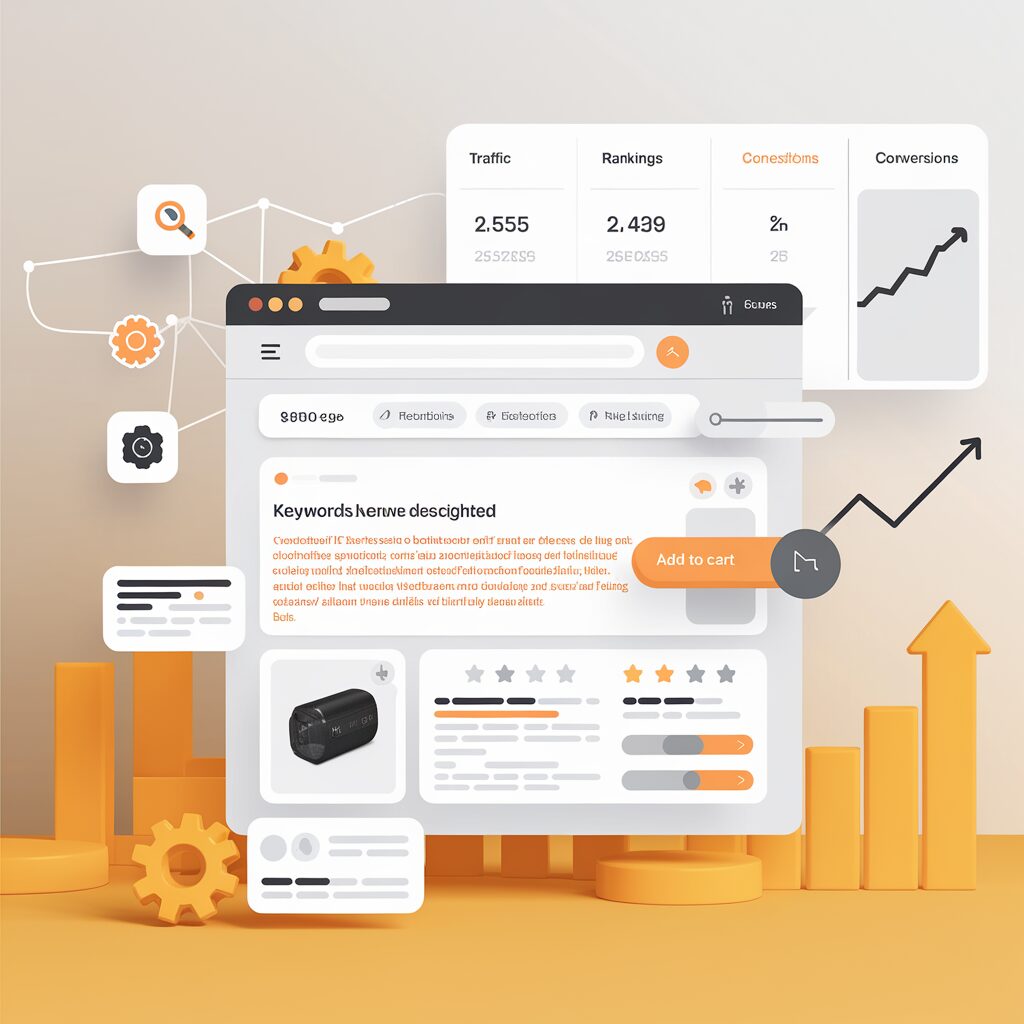
Creating Unique and Informative Product Descriptions
Product descriptions are another key element of product page SEO. They provide more detailed information about the product, helping users decide whether to make a purchase. A well-written product description can also help your page rank for long-tail keywords and related search queries.
When writing product descriptions, focus on the features and benefits of the product. Explain how the product can solve a problem or meet a need for the user. Use your target keywords naturally within the description, but avoid keyword stuffing. Also, make your descriptions unique for each product.
Duplicate content can harm your SEO, so avoid using the same description for similar products. Remember, your product descriptions are not just for search engines. They are also for your users, so make them engaging and persuasive to encourage conversions.
Leveraging High-Quality Visual Content
Visual content is a powerful tool in your product page SEO strategy. High-quality images and videos can significantly enhance user engagement on your product pages. They provide a more detailed view of your products, helping users make informed purchase decisions.

But it’s not just about having great visuals. You also need to optimize them for SEO to ensure they contribute to your page’s visibility in search engine results.
Here are some key points to consider:
- Use high-resolution images and videos that clearly showcase your product.
- Compress your images to reduce file size without compromising quality.
- Include a variety of images from different angles or videos showing the product in use.
- Use unique images and videos rather than stock content for better SEO performance.
Let’s delve deeper into how to optimize your visual content for SEO.
Optimizing Images and Videos for SEO
Images and videos can be a great source of organic traffic if properly optimized. Search engines like Google have separate search tabs for images and videos, providing another avenue for visibility. To optimize your images and videos, start by choosing the right file format.
JPEG is generally best for images due to its balance of quality and file size. For videos, formats like MP4 are widely supported and offer good quality. Also, compress your files to reduce their size, improving your page load speed, a crucial SEO factor.
Using Alt Text and File Names Strategically
Alt text and file names are often overlooked aspects of image SEO. Alt text is a description of an image that helps search engines understand what the image is about. It’s also used by screen readers for visually impaired users, enhancing your site’s accessibility.
File names, on the other hand, can give search engines clues about your image’s subject matter. Instead of a generic file name like “IMG_001.jpg”, use descriptive, keyword-rich file names. For example, “red-leather-sofa.jpg” is much more informative and SEO-friendly.
Remember, while it’s good to include keywords in your alt text and file names, they should be relevant and accurately describe the image. Avoid keyword stuffing as it can lead to penalties from search engines.
Enhancing User Experience (UX) for Better SEO
User experience (UX) is a critical factor in SEO. Search engines aim to provide users with the most relevant and high-quality results. If your product pages offer a great user experience, they’re more likely to rank higher in search results.
But what does good UX look like for a product page? It involves several elements, from the design and layout of the page to the quality of the content. Your product pages should be easy to navigate, with clear, concise information about the product. They should also be visually appealing and engaging, encouraging users to spend more time on the page.
Mobile Optimization and Responsive Design
With more people using mobile devices to shop online, mobile optimization is a must for your product pages. A mobile-optimized page adjusts to fit the screen size of the device it’s viewed on. This makes it easier for users to navigate the page and find the information they need.
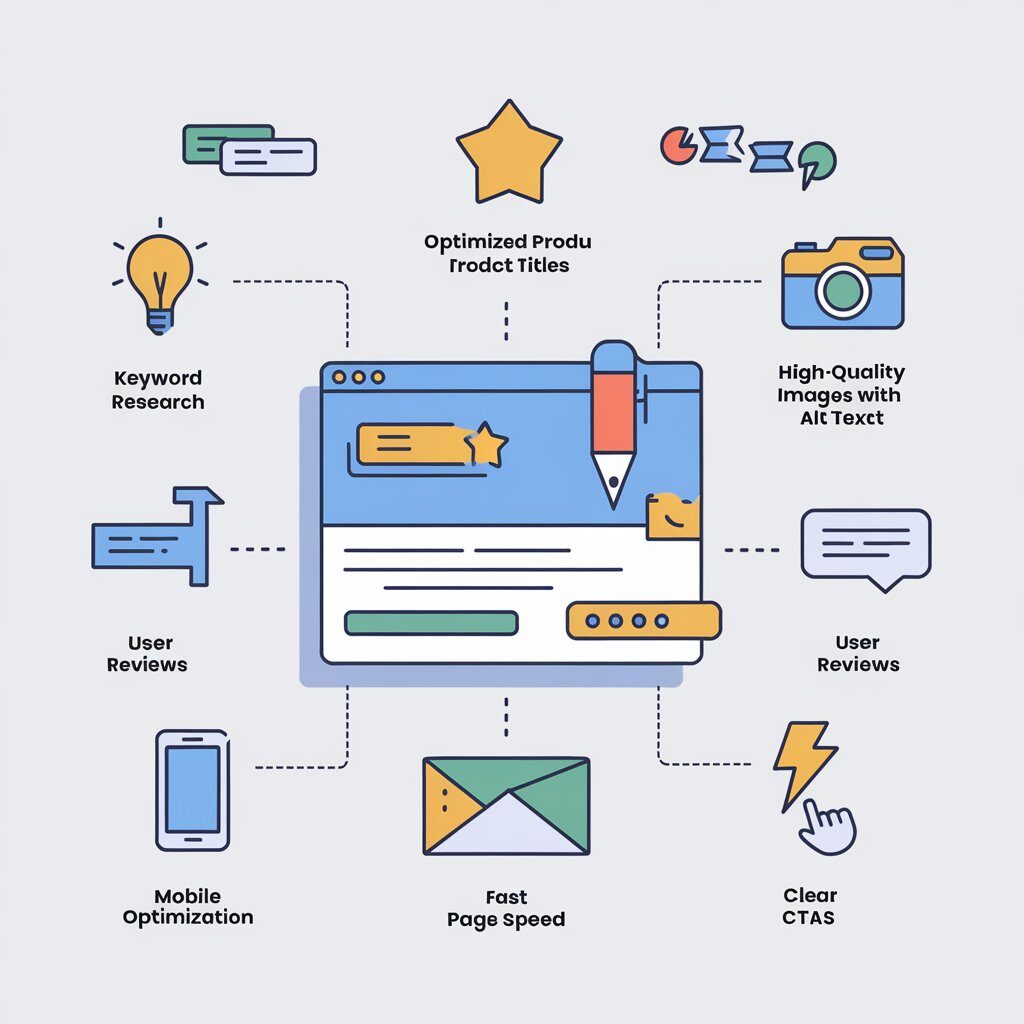
Responsive design is a key part of mobile optimization. It ensures that your product pages look and function well on all devices, from desktops to smartphones. This not only improves UX but also boosts your SEO, as search engines favor mobile-friendly websites.
Page Loading Speed and Its Impact on SEO
Page loading speed is another crucial aspect of UX and SEO. Users expect web pages to load quickly. If your product pages take too long to load, users may leave, increasing your bounce rate.
Search engines take note of this and may lower your ranking in search results. To improve your page loading speed, consider strategies like compressing images, enabling browser caching, and minimizing HTTP requests. Remember, a faster website not only improves UX but also gives you an edge in the competitive world of SEO.
Structured Data and Rich Snippets for Product Pages
Structured data is a powerful SEO tool. It helps search engines understand the content on your product pages. By adding structured data to your pages, you can provide search engines with specific information about your products. This includes details like price, availability, and review ratings.
When search engines understand your content, they can display it in more useful and attractive ways. This is where rich snippets come in. Rich snippets are search results that include extra information, like product ratings and prices. They make your product pages stand out in search results, potentially increasing click-through rates.
Implementing and Testing Structured Data
Implementing structured data involves adding specific code to your product pages. This code, often in JSON-LD format, provides search engines with detailed information about your products. There are various tools available to help you implement and test structured data.
Google’s Structured Data Testing Tool, for example, allows you to check your code for errors. It’s important to test your structured data to ensure it’s working correctly. Correct implementation can enhance your visibility in search results and improve your SEO.
The Benefits of Rich Snippets for Product Pages
Rich snippets can significantly enhance your product page SEO. They make your search results more attractive and informative, encouraging users to click through to your site. Rich snippets can include product ratings, prices, and availability information.

This additional information can help users make informed decisions right from the search results page. It can also set your products apart from competitors, potentially increasing your click-through rates. Remember, a higher click-through rate can lead to more traffic, more conversions, and ultimately, better SEO. So, implementing structured data and leveraging rich snippets can be a game-changer for your product page SEO.
Internal and External Link Building Strategies
Link building is a crucial part of SEO. It involves creating a network of links within your website and from other sites to your product pages. This network can significantly improve your product page SEO.
Internal and external links help search engines understand the content and importance of your pages. They also guide users through your website, improving their experience. Let’s delve into the power of internal linking and how to acquire high-quality backlinks.
The Power of Internal Linking
Internal linking refers to the links that connect your website’s pages. These links help users navigate your site and find relevant content. For product pages, internal links can guide users from your blog posts or category pages to specific products. This not only improves user experience but also boosts your SEO.
Search engines use internal links to discover new content on your site. They also use these links to understand the context and relationship between your pages. So, a well-planned internal linking strategy can enhance your product page SEO. Remember, the goal is to create a logical and user-friendly link structure.
Acquiring High-Quality Backlinks
Backlinks, also known as inbound or external links, are links from other websites to your product pages. They are a key factor in how search engines rank your pages. When a reputable site links to your product page, it signals to search engines that your content is valuable. Acquiring high-quality backlinks can be challenging, but it’s worth the effort.
You can earn backlinks by creating valuable content that others want to link to. You can also reach out to bloggers, influencers, or industry publications for product reviews or guest posting opportunities. Remember, the quality of your backlinks is more important than quantity.
So, focus on acquiring links from reputable and relevant sites. This will boost your product page SEO and drive more organic traffic to your site.
Technical SEO: Ensuring Your Product Pages are Search Engine Friendly
Technical SEO is a critical aspect of product page optimization. It involves making your product pages easy for search engines to crawl, index, and rank. This includes optimizing your URL structure, avoiding duplicate content, and ensuring your site is mobile-friendly.
Technical SEO also involves improving your site’s loading speed and implementing structured data. These factors can significantly impact your product page SEO. Let’s delve into the importance of URL structure and navigation, and how to use canonical tags to avoid duplicate content.
URL Structure and Navigation
The structure of your URLs can impact your product page SEO. Search engines use URLs to understand the content of your pages. So, it’s important to create clear, descriptive URLs for your product pages.

Your URLs should include your target keywords and be easy for users to understand. For example, a URL like “www.yoursite.com/women-shoes/red-heels” is more descriptive and SEO-friendly than “www.yoursite.com/product123”. Also, ensure your site navigation is user-friendly. This can improve user experience and help search engines understand the structure of your site.
Canonical Tags and Avoiding Duplicate Content
Duplicate content can harm your product page SEO. It can confuse search engines and lead to lower rankings. To avoid this, you can use canonical tags. These tags tell search engines which version of a page to index when there are similar or duplicate pages. For example, if you have the same product in different colors, you can use a canonical tag to specify the main product page.
This will prevent search engines from treating the color variations as duplicate content. Remember, the goal of technical SEO is to make your product pages easy for search engines to understand and rank. So, pay attention to your URL structure, avoid duplicate content, and ensure your site is user-friendly.
Conversion Rate Optimization (CRO) for Product Pages
Conversion Rate Optimization (CRO) is a crucial part of product page SEO. It involves optimizing your product pages to increase the percentage of visitors who complete a desired action. This could be making a purchase, signing up for a newsletter, or downloading a guide.
CRO is not just about driving traffic to your product pages. It’s about ensuring that traffic converts into sales. This involves creating clear calls-to-action, building user trust, and analyzing user behavior. Let’s explore these aspects in more detail.
Clear Calls-to-Action and User Trust Signals
A clear call-to-action (CTA) can significantly increase your conversion rate. Your CTA should be compelling and direct, telling users exactly what to do next. For example, instead of a vague “Click Here”, use a specific “Buy Now” or “Add to Cart”.
User trust signals are also important for CRO. These could be customer reviews, ratings, or security badges. They help build trust with your visitors, making them more likely to convert. Remember, a clear CTA and strong user trust signals can significantly improve your conversion rate.
A/B Testing and Analyzing User Behavior
A/B testing is a powerful tool for CRO. It involves testing two versions of a page to see which performs better. For example, you could test two different CTAs or product descriptions. The version that leads to more conversions is the one you should use. Analyzing user behavior can also help improve your conversion rate.
You can use tools like heatmaps to see where users are clicking on your page. This can give you insights into what’s working and what’s not. Remember, CRO is about understanding your users and optimizing your pages to meet their needs. So, use A/B testing and user behavior analysis to make data-driven decisions.
Monitoring and Adapting to Search Engine Algorithm Updates
Search engine algorithms are constantly evolving. They aim to provide the most relevant and high-quality results to users. As a result, your product page SEO strategies need to adapt to these changes. Staying informed about these updates is crucial. It can help you understand changes in your page rankings and traffic. Let’s delve deeper into how you can stay updated and use analytics to refine your strategies.
Staying Informed on SEO Trends and Best Practices
One way to stay updated is by following SEO news and blogs. These sources often provide insights into algorithm updates and SEO best practices. Remember, understanding these changes can help you adapt your strategies and maintain your page rankings.
Using Analytics to Refine SEO Strategies
Analytics tools can provide valuable insights into your product page performance. They can help you understand which strategies are working and which ones need improvement.

For example, if you notice a drop in traffic after an algorithm update, you may need to revise your SEO strategy. Remember, monitoring and adapting to algorithm updates is key to successful product page SEO.
Conclusion: Integrating Product Page SEO into Your Overall Marketing Strategy
Product page SEO is not a standalone task. It should be integrated into your overall marketing strategy. This holistic approach ensures that all your marketing efforts work together. It can help you achieve your business goals more effectively.
Recap of Key Product Page SEO Strategies
We’ve covered a lot of ground in this guide. From keyword research to technical SEO, we’ve discussed various strategies to optimize your product pages.
Next Steps and Continuous Improvement
But remember, SEO is not a one-time task. It requires continuous monitoring and improvement. Keep testing different strategies and refining your approach based on the results. And most importantly, stay updated with the latest SEO trends and algorithm updates. This will help you stay ahead of the competition and ensure your product pages continue to rank high in search engine results.


